Are you a fan of fans? They seem to swish in and out of favour and fashion among the collecting community.
Folding fans were introduced to Europe from China by Portuguese traders in the 1400s. By the 17th and 18th Centuries they were an essential part of social etiquette and could be put to several uses.
Not only did they fan freshness to their holder’s features, they could be used to indicate pleasure and approval. Ladies could flirt behind them. Catherine Moreland, Jane Austen’s heroine in Northanger Abbey, hides coyly behind one in front of Mr Tilney… “that she might not appear, however, to observe or expect him, she kept her eyes intently fixed on her fan.”
I am indebted to the Museum of London, one of my favourite haunts, for this week’s item, a late 19th century commemorative fan with portraits of heroes of the Boer War.
This was retailed by Perth’s biggest employer at the time – the dyeing and cleaning giant Pullar’s.
Essentially a souvenir of the British military victories in the Anglo-Boer War, 1900-1902, the fan comprises fabric-backed green paper leaves cut and printed in green, black, white and yellow to resemble pansies attached to wooden sticks.
On each leaf is mounted a portrait of a military hero, including General Roberts, Lord Kitchener and Baden-Powell.
If opened left to right it reveals the images of the heroes but, if opened right to left, only the pansies are visible.
First manufactured in 1900, the fan retailed at a price of 2/10d and was one of many souvenirs issued in response to public rejoicing at British victories in Mafeking, Kimberley and Ladysmith.
Picture: Pullar’s of Perth fan (Courtesy of The Museum of London).











